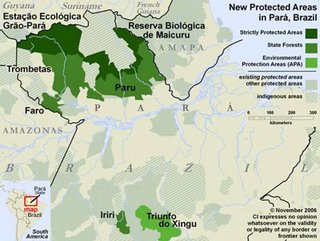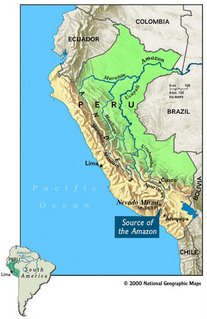 This week's widely published good news from the environmental front lines was the Brazilian state of Pará's decision to protect 15 million hectares (an area the size of Illinois) of the Northern Amazon.
This week's widely published good news from the environmental front lines was the Brazilian state of Pará's decision to protect 15 million hectares (an area the size of Illinois) of the Northern Amazon.
What was less intensively covered was a report from Peru revealing that their government has now signed away more than 39 million hectares of their remaining Amazon to oil and gas interests (an area equal to the size of California).
Until recently, Peruvian petroleum projects were resulting in massive quantities of contaminated wastewater, totaling 1 million barrels per day, being dumped directly into local rivers. Protests by aboriginal groups ended with new agreements to inject the contaminated water back underground as oil is extracted, but the threats to the water system continue. Of the 39 active operations currently underway, all but 8 were launched in past three years. That rate of expansion is expected to continue, and will inevitably cause more water diversions, greater deforestation, and increased risks of spills and dumping that will threaten not only local waters, but the lower reaches of the river.
Of the 39 active operations currently underway, all but 8 were launched in past three years. That rate of expansion is expected to continue, and will inevitably cause more water diversions, greater deforestation, and increased risks of spills and dumping that will threaten not only local waters, but the lower reaches of the river.
Peru is home to the very source of the Amazon, and any degradation of the river caused by Peruvian oil and gas will be carried down river to impact the health of downstream ecosystems potentially as far as Brazil, undermining more progressive conservation policies currently underway.
Lưu trữ Blog
-
▼
2006
(731)
-
▼
tháng 12
(77)
- Happy New Year!
- Playlist - 30th December 2006
- Google Earth: Space Navigator 3D controller
- We Don't Need No 'Uman Rights
- Fundraiser: Thanks to all our sponsors!
- The Day after
- Mountain Gorillas: News round-up
- Why We Came Here
- Big Brewing Weekend
- So This Is Christmas, And What Have We Done?
- Networking issues... I'm an idiot!
- New MacBook
- Playlist - 23rd December 2006
- Changes Ahead
- M.D. Lite
- Baiji Dolphins: Chinese to continue the search for...
- Mmph Grmph ?!
- The Top Ten Worst Christmas Songs of All Time
- keep smiling
- Free Copies of Gore's Film Available First Come, F...
- PwC Puts Its Money Where Its Mouth Is
- Komodo Dragons: 'Virgin births' for giant lizards
- Al Gore Burned In The Onion
- Grant Greens Official Party Status
- Fat Jeans
- Today's Root Vegetable
- Holiday Strategies
- The Awesome Blossom
- Australian Court Blocks Coal Mine on Climate Grounds
- Is it Christmas where you live?
- Playlist - 16th December 2006
- kids are back
- So Called PM Tackles Perceived Threat to His Job
- Harper Plans Green Sham III
- The World's Healthiest Pizza
- Pretty Attractive
- Three Gorges Drives Dolphin to Extinction
- Greed is not Good
- Microsurgery
- HUH?
- Kelly
- Toronto to Recycle 70% of All Garbage
- Host "An Incovenient Truth" House Party
- Ambrose Demands Audit of Dead Programs
- Holy Toledo, Batman, It's a New Addiction
- Talking to Myself
- Clang
- Elk Return to BC's Lower Mainland
- BC Accepts Four Bids for Park Development
- Join the Collection
- Playlist - 9th December 2006 - Funkology
- This One's For Liz
- NSTA's Truth is Full of Holes
- Responsible Tar Sands Time Has Come
- One Step Forward, Two Steps Back for Amazon
- Stuck on Stupid
- Karmic Gold
- Hey U
- Hike For Discovery 2007
- Sydney
- ScottishPower Will Pay for Students to See the "Tr...
- James Kim Dead
- Lead Free Plasma TVs from Panasonic
- Al Gore on Oprah Today
- An Ounce of Cure
- Values Hoist Dion to Victory
- A Pound of Pleasure
- Hopscotch
- Help find James Kim
- A New Direction
- Playlist - 2nd December 2006
- WSJ Article
- Quoted in the Wall Street Journal
- CNET Editor and Family Still Missing - Search Unde...
- kids
- Dub Review - December 2006
- Head Hunger
-
▼
tháng 12
(77)